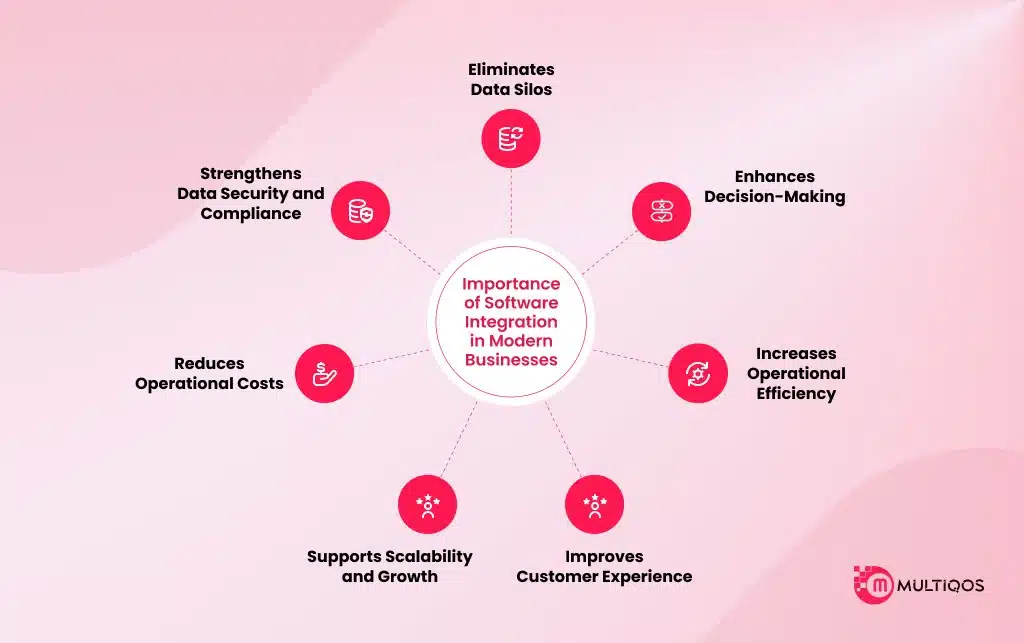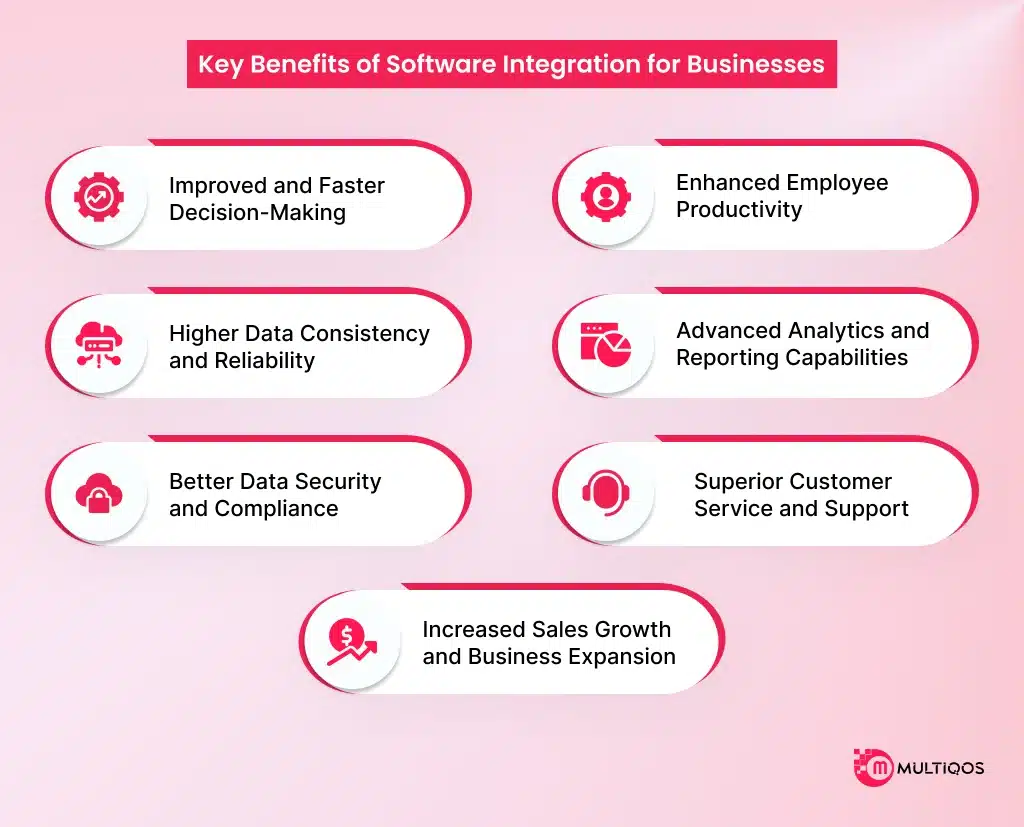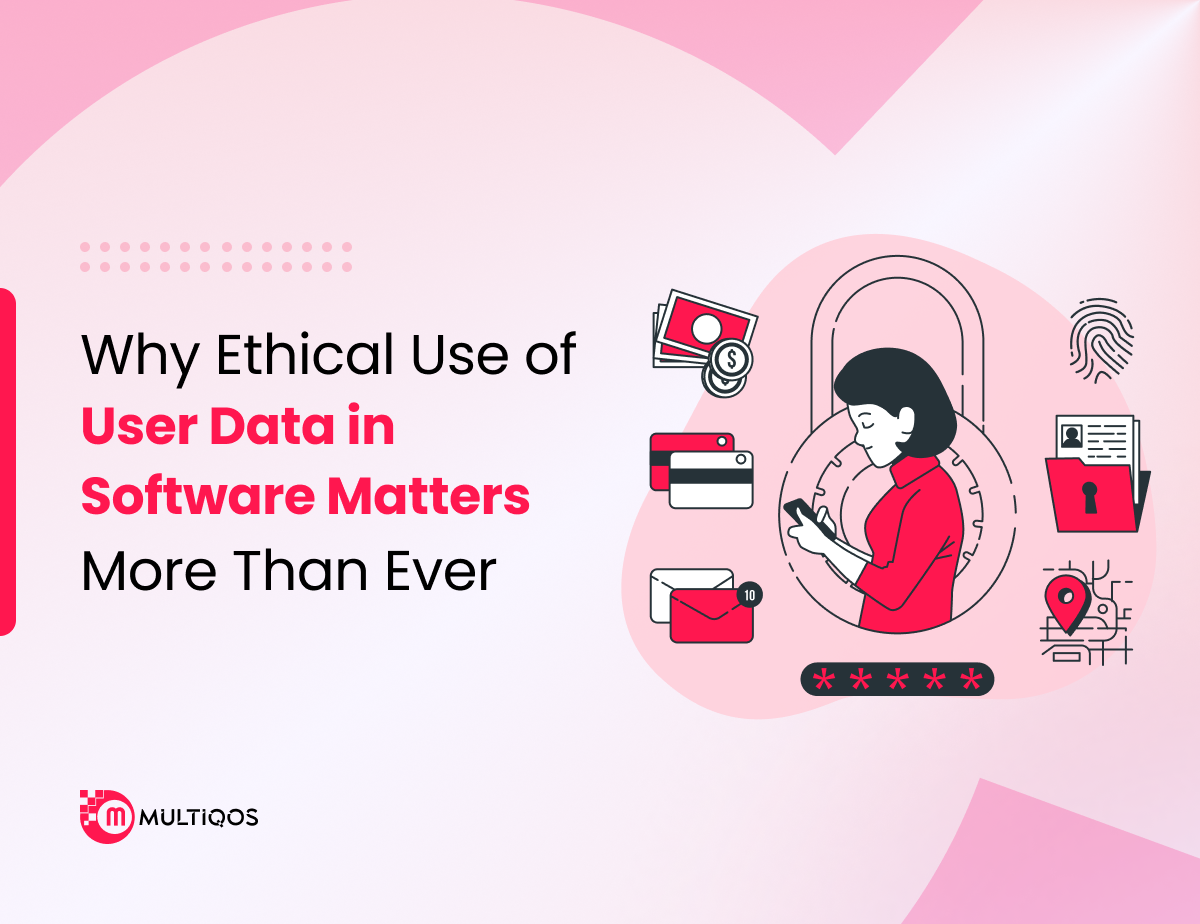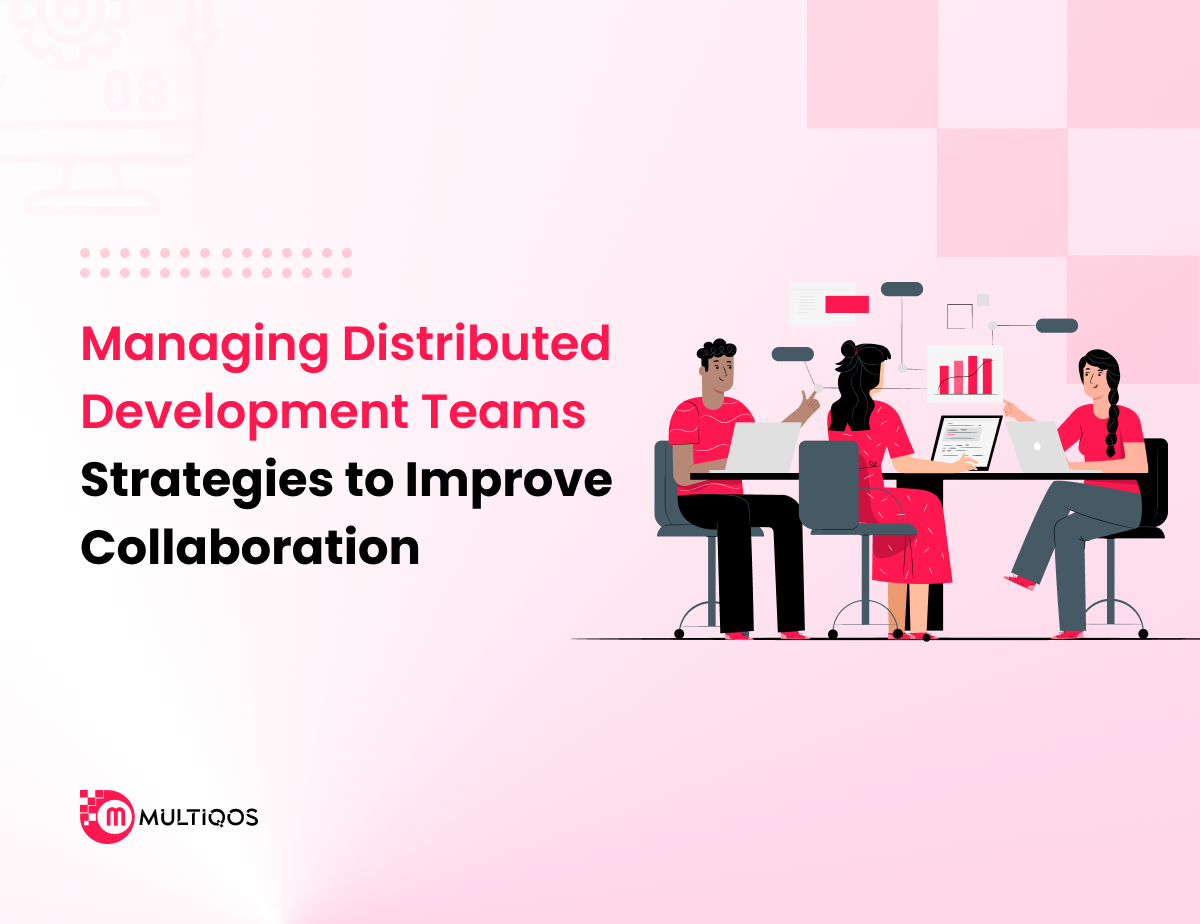Software Integration for Business: A Complete Guide to Types, Benefits, and Process
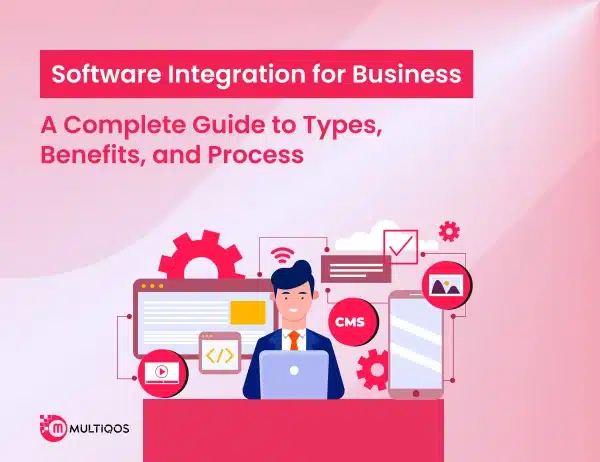
Table of Contents:
- Introduction
- What is Software Integration for Business?
- Importance of Software Integration in Modern Businesses
- Types of Software Integrations for Your Business
- Step-by-Step Software Integration Process for Businesses
- Real-World Examples of Business Software Integration
- Key Benefits of Software Integration for Businesses
- How Software Integration Impacts Overall Business Operations
- Why Choose MultiQoS for Your Software Integration Needs
- Conclusion
- FAQs
Summary
Software integration solutions are essential for connecting various software systems into a unified, efficient ecosystem. In today’s digital landscape, businesses rely on multiple applications across departments—sales, HR, finance, and operations. Without integration, these systems operate in silos, causing data inconsistencies and operational inefficiencies.
Software integration for business ensures seamless data flow, improves productivity, and enhances decision-making. This blog explores the concept of software integration, its importance, types, implementation process, real-world examples, benefits, and how MultiQoS can help your organization achieve seamless integration.
Introduction
As businesses grow, so does the complexity of their software ecosystems. Different departments often adopt specialized tools for tasks like customer relationship management (CRM), enterprise resource planning (ERP), marketing automation, and customer support. Without proper connectivity between these systems, businesses face fragmented workflows, duplicated data, and missed opportunities.
Software integration for business addresses this challenge by creating seamless connections between diverse applications, allowing data and processes to flow freely across platforms. Whether you’re a small startup or an enterprise-level organization, software integration is vital for optimizing operations, improving decision-making, and staying competitive in an increasingly digital world.
What is Software Integration for Business?
Integrating Software for businesses refers to the process of connecting different software applications, systems, or platforms to work together as a cohesive, unified solution. Instead of operating in isolation, integrated systems share information, automate workflows, and create a centralized source of truth across departments.
At its core, business software integration aims to improve efficiency, eliminate data silos, and enhance the overall performance of an organization. Whether integrating internal tools like CRM systems and accounting software or external solutions like cloud services and APIs, the goal is to ensure that every system speaks the same language and collaborates effectively.
Importance of Software Integration in Modern Businesses
In today’s fast-paced digital economy, businesses rely on multiple specialized software systems to manage daily operations. However, when these systems operate independently, it leads to inefficiencies, communication gaps, and duplicated efforts. Software integration for business ensures that information flows smoothly between departments, helping companies deliver faster services, make data-driven decisions, and adapt quickly to market changes.
Eliminates Data Silos
When systems are not integrated, valuable information becomes trapped within individual departments. Software integration solutions enable smooth data flow across platforms, giving teams unified access to critical information. This connectivity improves collaboration, reduces errors, and ensures that all business units are working with consistent and up-to-date data.
Enhances Decision-Making
Integrated systems provide business leaders with real-time insights by pulling data from multiple sources into a centralized dashboard. Business software integration empowers decision-makers to analyze complete, accurate information quickly. As a result, businesses can make smarter, faster decisions that drive growth, enhance operational efficiency, and strengthen market positioning.
Increases Operational Efficiency
Manual data entry, duplicate processes, and disjointed workflows waste valuable time and resources. With software integration for business, companies can automate routine tasks, streamline processes, and minimize redundancies. By boosting operational efficiency, businesses can allocate their resources more effectively and focus on strategic initiatives that fuel expansion.
Improves Customer Experience
Customers today expect fast, seamless service across all channels. Integrated systems ensure that customer data is consistent, accurate, and easily accessible at every interaction point. Business software integration enables personalized service delivery, faster support response times, and better customer relationship management, leading to stronger loyalty and higher retention rates.
Supports Scalability and Growth
As organizations grow, managing a larger number of tools and processes becomes increasingly complex. Software integration for business provides a scalable framework that makes it easy to add new applications, services, or departments without disrupting operations. A well-integrated infrastructure lays the foundation for sustainable, long-term business growth.
Reduces Operational Costs
Disconnected systems can result in higher IT costs, inefficient processes, and resource wastage. Business software integration helps reduce overhead by eliminating duplicate software tools, minimizing manual interventions, and optimizing workflows. Over time, these efficiencies lead to significant cost savings, allowing companies to reinvest in growth and innovation.
Strengthens Data Security and Compliance
Managing multiple disconnected platforms increases the risk of security breaches and compliance failures. Software integration for business centralizes data management, making it easier to enforce security protocols, monitor access, and ensure compliance with regulations like GDPR or HIPAA. A unified system improves overall cybersecurity and safeguards sensitive business information.
Types of Software Integrations for Your Business
Choosing the right type of integration is crucial to the success of your digital transformation. Different models offer various benefits depending on your business needs, infrastructure, and scalability goals. In this section, we’ll explore the most common types of software integrations businesses use to streamline operations and enhance connectivity.
Standard Data Format Integration
Standard data format integration uses common data structures like XML or JSON to allow different software systems to exchange information efficiently. By adopting a shared language, businesses can connect diverse applications with minimal complexity. This approach is ideal for organizations looking for straightforward, cost-effective solutions to support their growing integration needs.
Star Integration Model
In the star integration model, each system connects directly to every other system through individual interfaces. While this model provides strong, immediate communication between applications, it can become complicated as the number of systems increases. Star integration is suitable for smaller businesses or environments with limited software tools that require fast connections.
Enterprise Service Bus (ESB) Integration
Enterprise Service Bus (ESB) integration uses a central communication channel where multiple systems connect through a shared platform. This model improves scalability, flexibility, and control by decoupling systems from one another. ESB is widely used in enterprise software integration projects where managing many complex connections efficiently is critical.
Vertical Software Integration Approach
Vertical integration focuses on connecting systems within a specific department or business function, creating a streamlined flow of information in a siloed structure. While this approach enhances operational efficiency within individual units, it may not support cross-department collaboration as effectively as other models. It’s ideal for businesses prioritizing departmental specialization.
Step-by-Step Software Integration Process for Businesses
Implementing software integration solutions requires a clear, strategic approach. Following a structured process ensures that systems connect effectively and deliver long-term value. Let’s walk through the essential stages involved in achieving successful software integration for your organization.
Gathering and Defining Integration Requirements
The first step is to identify and document the specific needs of your business. What systems need to be connected? What are the desired outcomes? Gathering precise requirements ensures that the integration plan is aligned with business objectives and user expectations right from the beginning.
Conducting Feasibility and System Analysis
Before moving forward, it’s critical to assess the technical feasibility of the proposed integration. This stage involves evaluating system compatibility, security risks, data formats, and potential obstacles. A thorough analysis helps in minimizing integration risks and ensuring a smoother implementation process.
Designing the Integration Architecture and Management Strategy
In this phase, businesses create a detailed integration architecture outlining how systems will connect and communicate. It also includes setting up management plans, defining responsibilities, and establishing data governance protocols. A solid architecture ensures seamless performance and scalability of the integrated environment.
Developing the Integrated Software System
The development phase involves coding, configuring, and testing the connections between applications. Developers use APIs, middleware, or custom-built solutions to establish secure and reliable communication. During this step, it’s crucial to maintain best practices for security, error handling, and data consistency.
Deployment, Implementation, and User Training
Once development is complete, the integrated system is deployed into the live environment. This stage includes thorough testing, troubleshooting, and user training. Successful user adoption depends on how well employees are prepared to work with the new system and its workflows.
Performance Evaluation and Continuous Optimization
After deployment, ongoing monitoring is essential to evaluate system performance, identify issues, and gather feedback. Continuous optimization ensures that the integration continues to meet business goals, adapts to changing requirements, and delivers maximum return on investment over time.
Real-World Examples of Business Software Integration
Understanding practical applications of software integration for business helps illustrate its real-world value. Below are examples where integration transforms operations, enhances customer experiences, and improves business efficiency across industries.
CRM and Marketing Automation System Integration
Integrating CRM platforms like Salesforce with marketing automation tools such as HubSpot enables businesses to synchronize customer data across departments. This connection automates lead nurturing, aligns sales and marketing efforts, and personalizes campaigns based on customer behavior. It helps businesses improve lead conversion rates and build stronger, more targeted customer relationships.
ERP and HRMS Software Integration
Connecting enterprise resource planning (ERP) systems like SAP with human resource management systems (HRMS) such as Workday streamlines complex employee management tasks. Payroll, benefits administration, recruitment, and compliance reporting become automated and consistent. This integration boosts collaboration between HR and finance teams while ensuring better data accuracy and regulatory compliance.
eCommerce Platform and Payment Gateway Integration
E-commerce platforms like Shopify or WooCommerce can integrate directly with payment gateways such as Stripe or PayPal. This integration ensures fast, secure transactions, real-time inventory updates, and seamless checkout experiences. It minimizes cart abandonment, builds customer trust, and helps businesses expand into new markets more efficiently with reliable payment processing.
Customer Support Tools and CMS Integration
Linking customer support platforms like Zendesk with content management systems (CMS) such as WordPress centralizes customer interactions and content resources. Support teams can access knowledge bases, customer histories, and tickets from a unified interface. This integration results in quicker resolution times, better support experiences, and higher customer satisfaction rates.
Cloud Storage and Team Collaboration Software Integration
Integrating cloud storage services like Google Drive or Dropbox with collaboration platforms like Slack or Asana enhances workflow visibility and document management. Teams can instantly share updated files, assign tasks, and track project milestones without switching between systems. This setup boosts team productivity, improves transparency, and supports remote collaboration.
API Integrations Across Business Applications
API integrations allow different business applications to communicate seamlessly without major redevelopment. Whether linking accounting systems like QuickBooks with CRM tools or connecting marketing platforms to data analytics dashboards, APIs accelerate innovation. They enable businesses to customize workflows, enhance data connectivity, and respond more quickly to evolving customer and market needs.
Key Benefits of Software Integration for Businesses
Investing in software integration solutions brings numerous advantages that extend beyond simple connectivity. Integrated systems enhance the way businesses operate, serve customers, and adapt to changing market demands. Here’s how software integration can transform your organization.
Improved and Faster Decision-Making
With integrated systems providing real-time access to accurate and comprehensive data, decision-making becomes faster and more reliable. Leaders no longer need to compile information from multiple sources manually. Business software integration ensures that data insights are available instantly, supporting proactive strategies and enabling businesses to respond quickly to market changes.
Enhanced Employee Productivity
Disconnected systems slow down processes and increase the likelihood of errors. By connecting critical business tools, software integration for business eliminates redundant manual tasks and allows employees to work more efficiently. Teams can collaborate better, complete projects faster, and focus their energy on high-value activities instead of administrative work.
Higher Data Consistency and Reliability
When systems operate in silos, inconsistencies in data are inevitable. Integration ensures that information is updated across all connected platforms in real time, creating a single source of truth. This improved data consistency reduces mistakes, strengthens reporting accuracy, and builds greater trust across departments relying on shared business data.
Advanced Analytics and Reporting Capabilities
Integrated software ecosystems pull data from different systems into unified dashboards and reporting tools. This enables businesses to perform deeper analysis, identify trends, and make data-driven decisions faster. Organizations often hire software developers with specialized integration expertise to build customized solutions that maximize these analytics capabilities and support strategic growth.
Better Data Security and Compliance
Managing multiple separate systems often increases security risks and makes compliance more complicated. Business software integration helps centralize data management, making it easier to enforce consistent security protocols, control user access, and comply with industry regulations like GDPR or HIPAA. An integrated system enhances overall cybersecurity resilience.
Superior Customer Service and Support
When customer information is accessible across sales, support, and marketing platforms, service teams can deliver faster, more personalized responses. Integration ensures that agents have complete customer histories at their fingertips. This leads to higher customer satisfaction rates, stronger loyalty, and a more cohesive brand experience across all touchpoints.
Increased Sales Growth and Business Expansion
Efficient operations, real-time insights, and superior customer experiences all contribute to improved sales performance. Software integration solutions supports cross-selling and upselling opportunities by giving teams a 360-degree view of customers. Additionally, it enables businesses to scale operations smoothly, expand into new markets, and stay ahead of competitors.
How Software Integration Impacts Overall Business Operations
Implementing software integration for business fundamentally transforms the way organizations function across all departments. Instead of managing disconnected tools, businesses create a unified digital environment where systems share data effortlessly and processes are streamlined. Here’s how software integration positively impacts business operations:
Enhanced Efficiency
Integrated systems eliminate repetitive manual tasks and automate workflows, freeing up employees to focus on higher-value initiatives. Teams complete projects faster, reduce human errors, and operate with greater precision.
Better Cross-Department Collaboration
When different departments like sales, marketing, finance, and customer service share real-time data, collaboration improves dramatically. Information silos disappear, leading to faster communication and more aligned goals across teams.
Improved Scalability
As businesses grow, integrated systems can easily handle increased transactions, users, and data volumes without the need for major system overhauls. This scalability is crucial for businesses aiming for long-term, sustainable growth.
Stronger Business Resilience
Centralized data management and automated processes make it easier for businesses to recover from unexpected disruptions. Software integration supports business continuity, ensuring critical functions stay operational even during challenges.
Data-Driven Decision Making
With unified analytics and reporting tools, leadership teams gain real-time insights into business performance. They can anticipate market trends, allocate resources more effectively, and make proactive decisions based on reliable, up-to-date information.
Why Choose MultiQoS for Your Software Integration Needs
Choosing the right technology partner is essential for the success of software integration for business. MultiQoS, a leading software development company, offers tailored integration solutions designed to meet the unique demands of businesses across various industries. With a strong focus on quality, security, and scalability, we help companies streamline operations, enhance system performance, and drive sustainable growth. Our proven expertise, agile methodologies, and commitment to client success make us a trusted choice for businesses looking to unlock the full potential of their digital infrastructure.
- Industry Expertise: We deliver specialized solutions for industries like eCommerce, finance, healthcare, and SaaS.
- Custom Integration Plans: Every project is built to match your specific operational and technical requirements.
- Agile and Scalable Solutions: Our integration processes are fast, flexible, and designed to grow with your business.
- Data Security and Compliance: We prioritize data protection with robust security measures and full regulatory compliance.
- End-to-End Project Support: From consultation to maintenance, we offer full-cycle support to ensure long-term success.
Conclusion
Software integration has become a strategic necessity for businesses aiming to stay competitive and agile in today’s fast-evolving digital landscape. Implementing software integration for business not only streamlines operations but also enhances collaboration, strengthens customer relationships, and empowers smarter decision-making. Whether your goal is automation, scalability, or improved data security, integrating your systems can unlock new levels of efficiency and growth.
By partnering with an experienced software development company like MultiQoS, you gain a trusted ally who can guide you through a seamless integration journey. If you are ready to modernize your operations and drive sustainable success, now is the perfect time to prioritize software integration.
FAQs
Software integration solutions connects different software applications to function as a unified system. It enables seamless data sharing, automated workflows, and better collaboration across departments, ultimately improving efficiency, decision-making, and customer experiences.
As businesses expand, managing multiple standalone systems becomes complex and inefficient. Software integration streamlines operations, reduces manual work, improves data consistency, and provides a stronger foundation for scaling operations and entering new markets.
The timeline for a software integration project can vary depending on the complexity, number of systems involved, and customization requirements. Simple integrations might take a few weeks, while large-scale, enterprise-level projects may span several months for full implementation and testing.
Virtually all industries benefit from business software integration, especially sectors like eCommerce, finance, healthcare, manufacturing, and SaaS companies. Integrated systems help these businesses improve efficiency, enhance customer service, and gain a competitive advantage in their markets.
A software development company like MultiQoS provides end-to-end integration services, from requirement analysis and system architecture design to development, deployment, and ongoing support. We ensure your business systems are connected securely, efficiently, and in alignment with your growth goals.
Get In Touch

